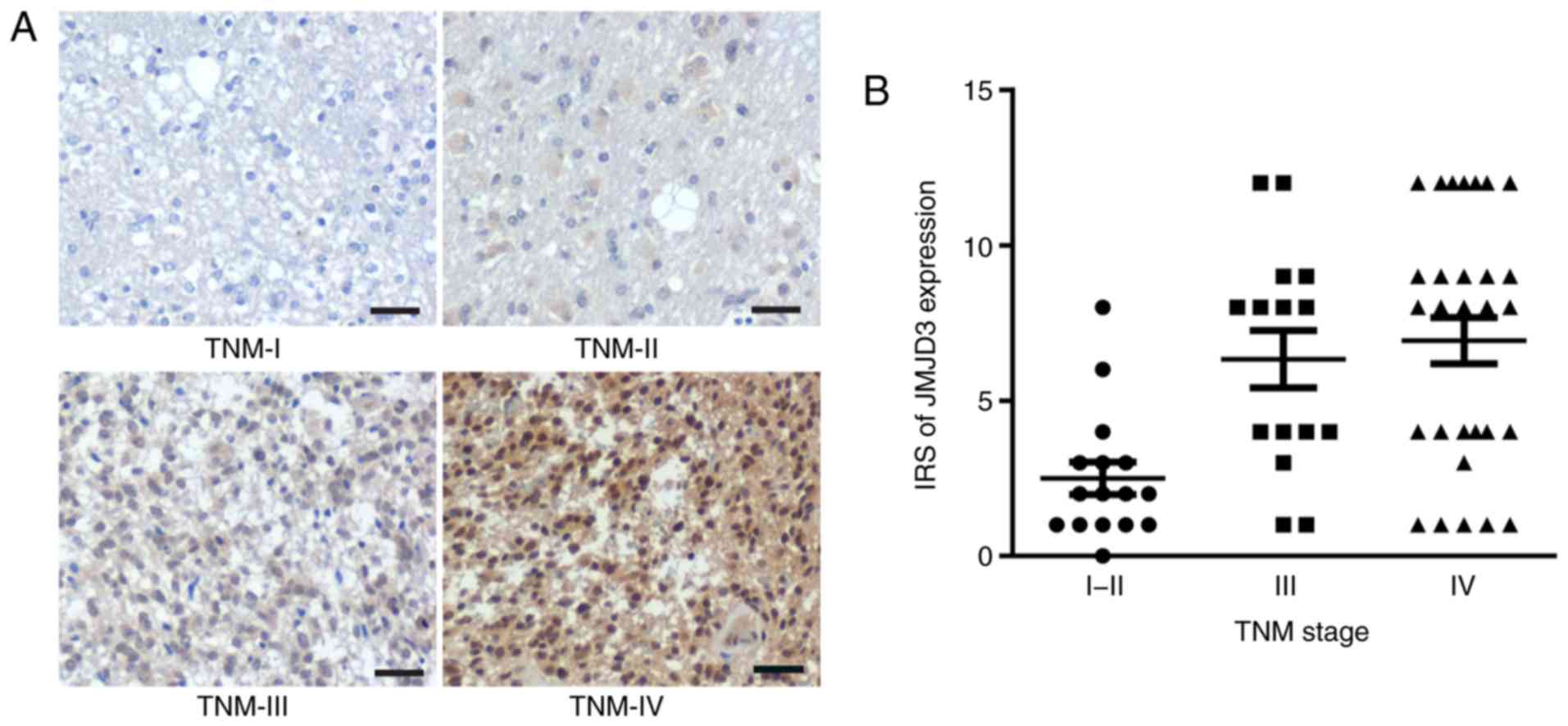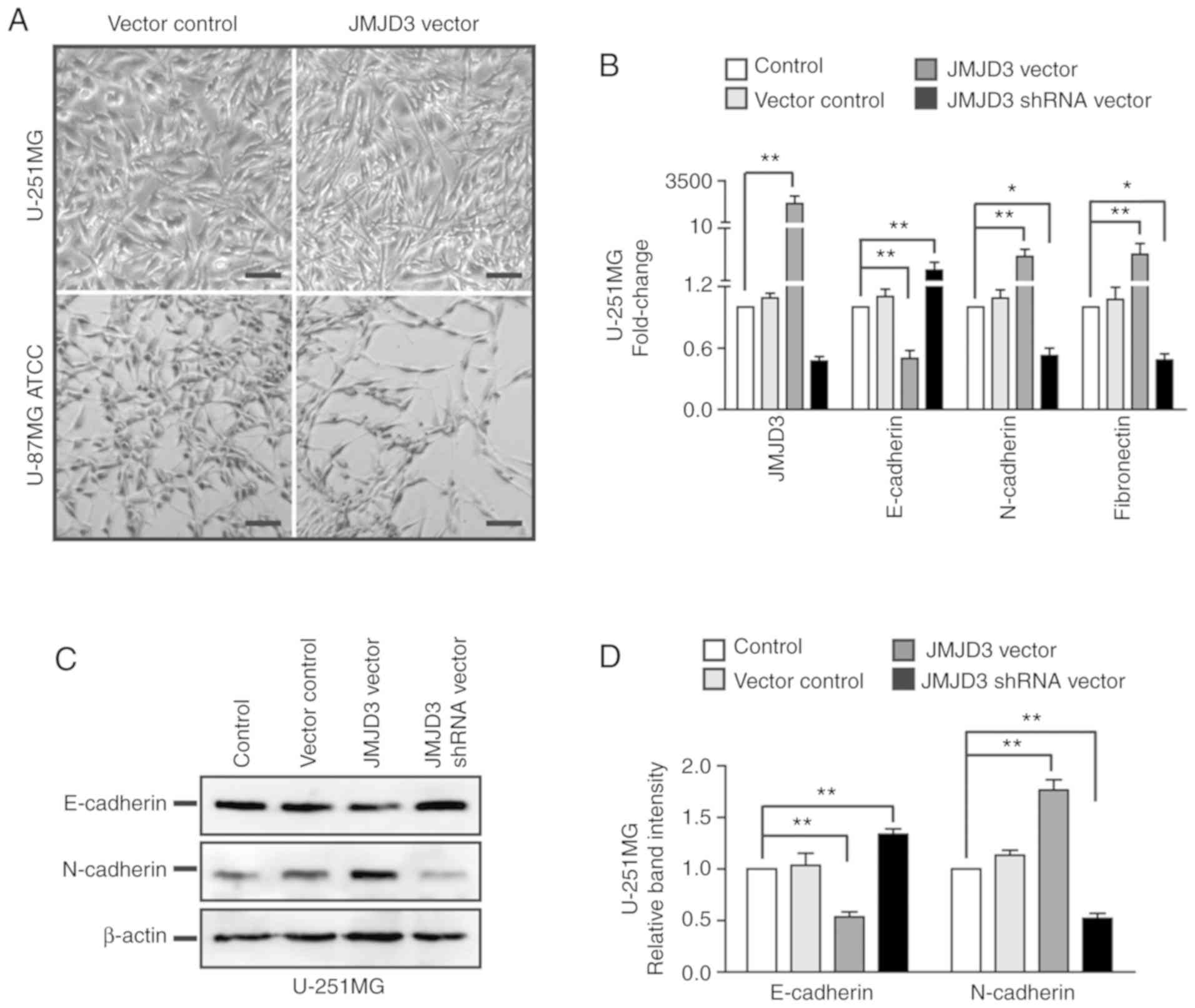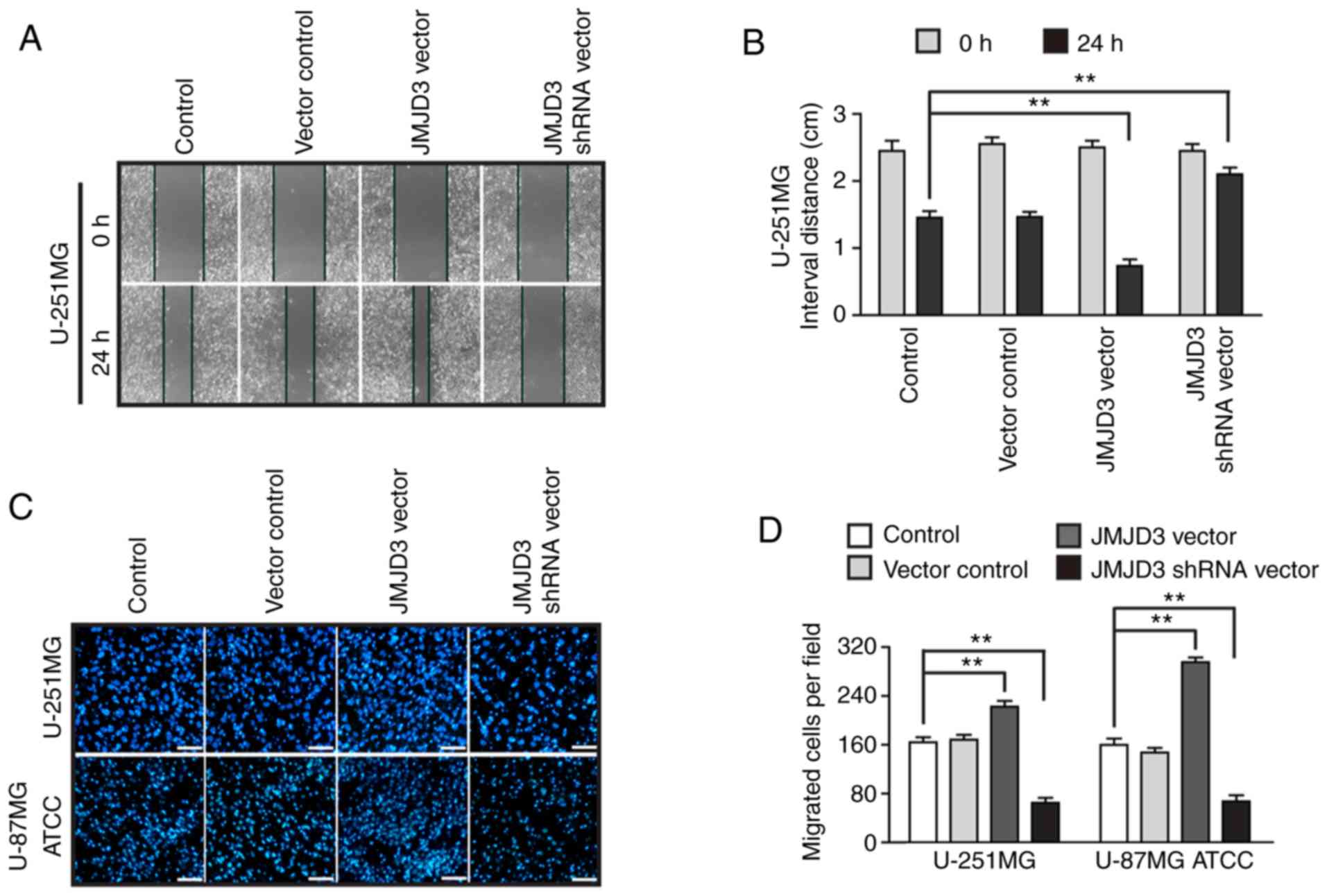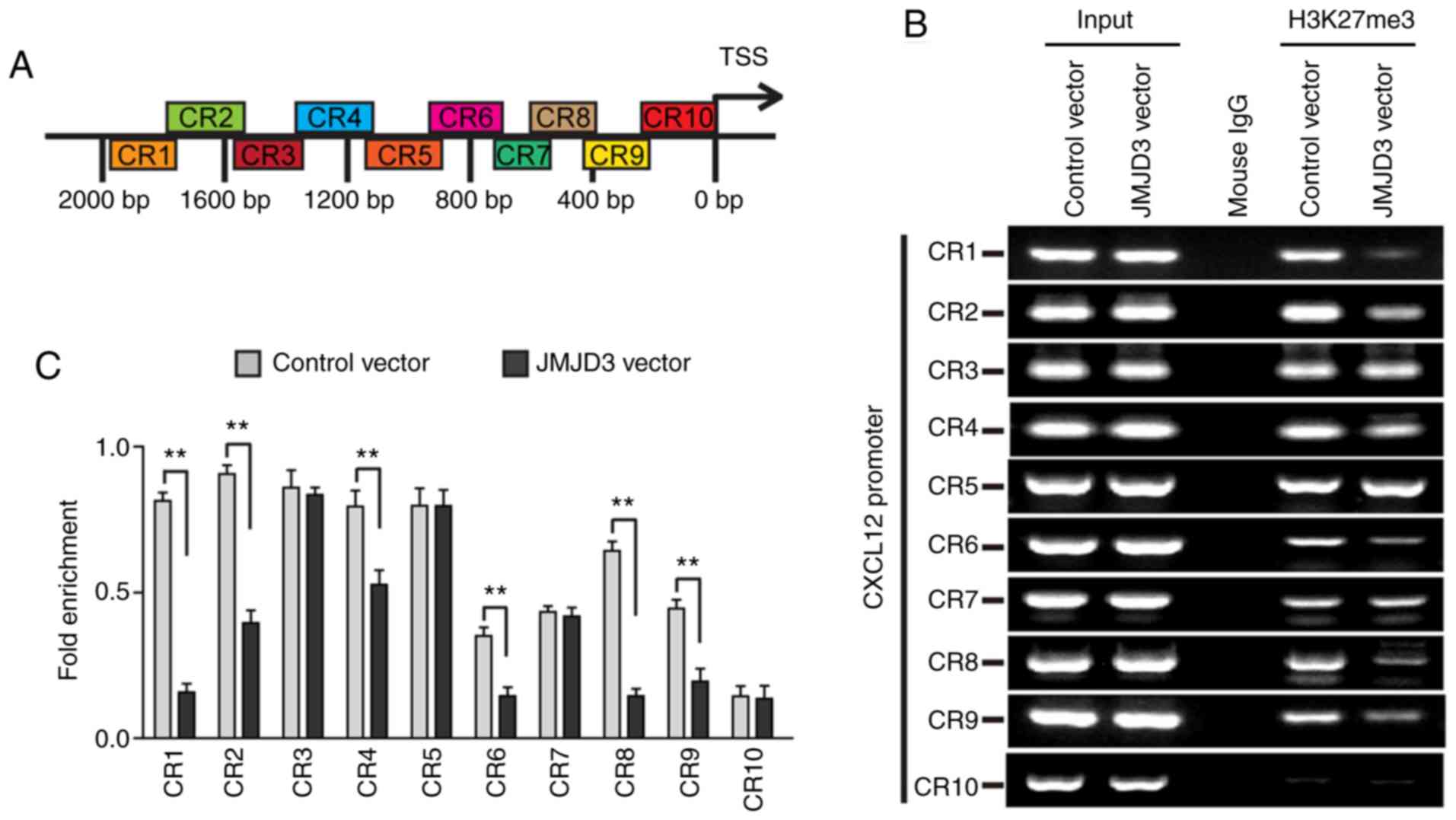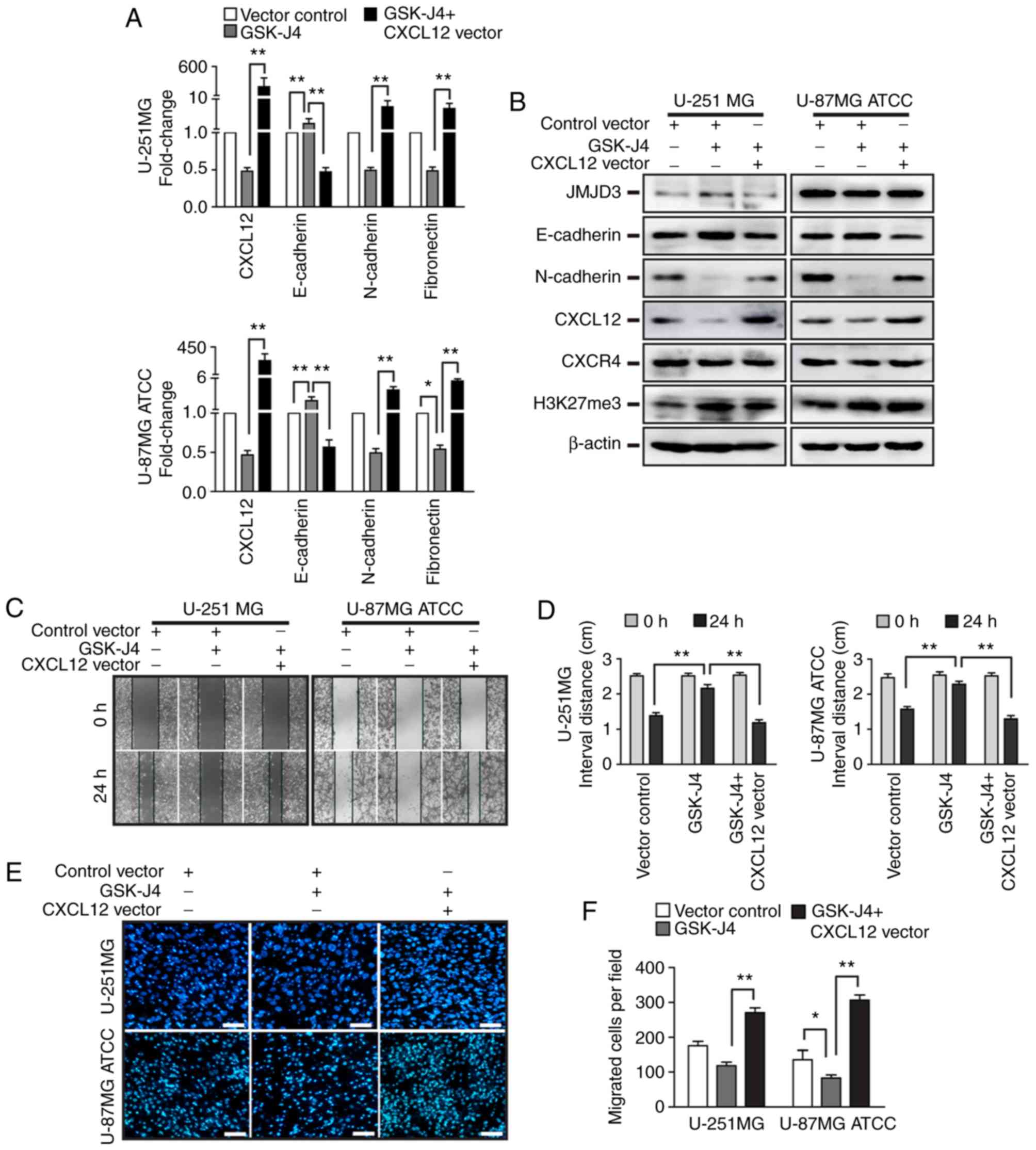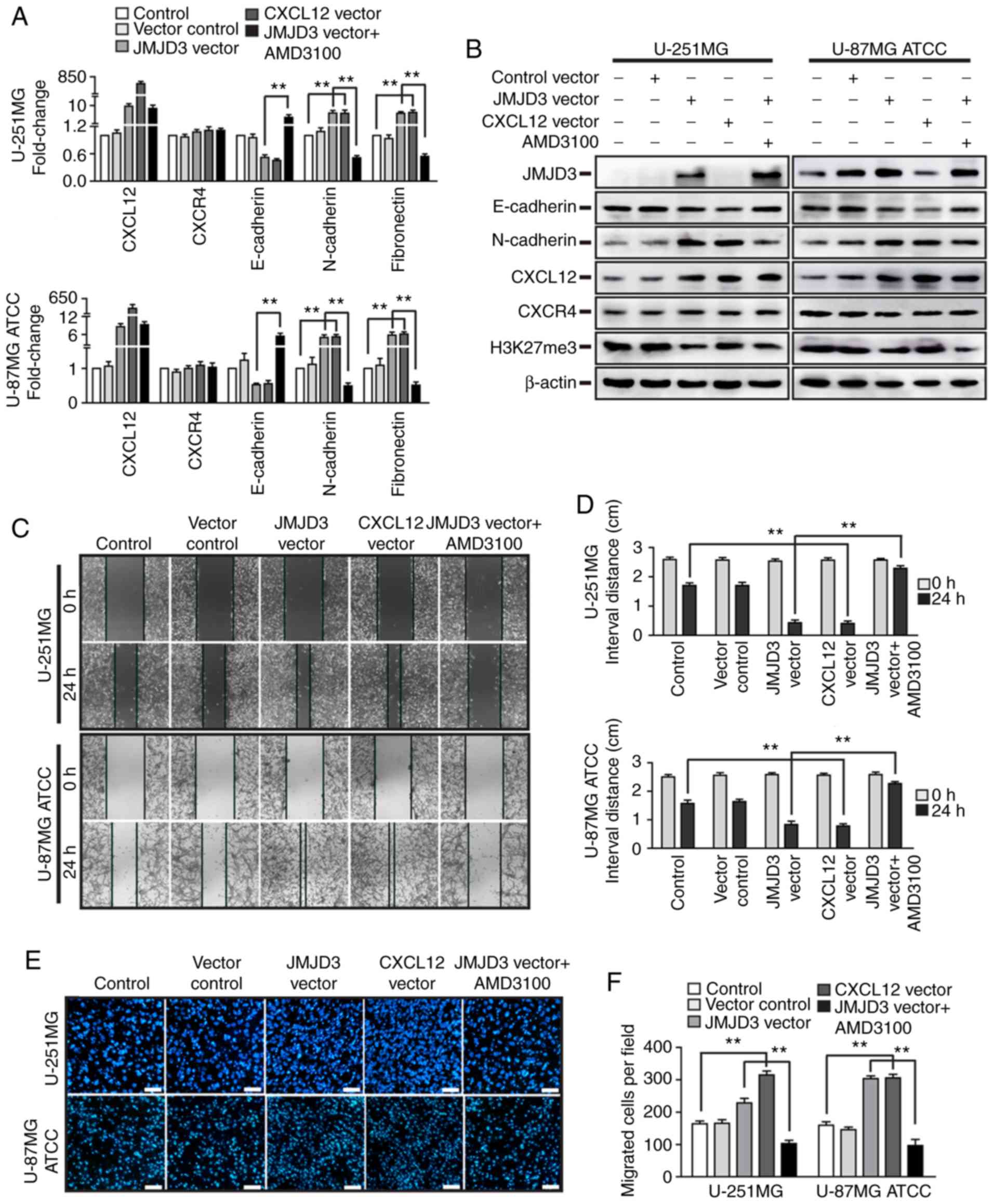|
1
|
Cloos PA, Christensen J, Agger K and Helin
K: Erasing the methyl mark: Histone demethylases at the center of
cellular differentiation and disease. Genes Dev. 22:1115–1140.
2008. View Article : Google Scholar : PubMed/NCBI
|
|
2
|
Yu SH, Zhu KY, Chen J, Liu XZ, Xu PF,
Zhang W, Yan L, Guo HZ and Zhu J: JMJD3 facilitates C/EBPβ-centered
transcriptional program to exert oncorepressor activity in AML. Nat
Commun. 9:33692018. View Article : Google Scholar : PubMed/NCBI
|
|
3
|
Williams K, Christensen J, Rappsilber J,
Nielsen AL, Johansen JV and Helin K: The histone lysine demethylase
JMJD3/KDM6B is recruited to p53 bound promoters and enhancer
elements in a p53 dependent manner. PLoS One. 9:e965452014.
View Article : Google Scholar : PubMed/NCBI
|
|
4
|
Hubner MR and Spector DL: Role of H3K27
demethylases Jmjd3 and UTX in transcriptional regulation. Cold
Spring Harb Symp Quant Biol. 75:43–49. 2010. View Article : Google Scholar : PubMed/NCBI
|
|
5
|
Agger K, Cloos PA, Rudkjaer L, Williams K,
Andersen G, Christensen J and Helin K: The H3K27me3 demethylase
JMJD3 contributes to the activation of the INK4A-ARF locus in
response to oncogene- and stress-induced senescence. Genes Dev.
23:1171–1176. 2009. View Article : Google Scholar : PubMed/NCBI
|
|
6
|
Barradas M, Anderton E, Acosta JC, Li S,
Banito A, Rodriguez-Niedenführ M, Maertens G, Banck M, Zhou MM,
Walsh MJ, et al: Histone demethylase JMJD3 contributes to
epigenetic control of INK4a/ARF by oncogenic RAS. Genes Dev.
23:1177–1182. 2009. View Article : Google Scholar : PubMed/NCBI
|
|
7
|
Sui A, Xu Y, Li Y, Hu Q, Wang Z, Zhang H,
Yang J, Guo X and Zhao W: The pharmacological role of histone
demethylase JMJD3 inhibitor GSK-J4 on glioma cells. Oncotarget.
8:68591–68598. 2017. View Article : Google Scholar : PubMed/NCBI
|
|
8
|
De Santa F, Narang V, Yap ZH, Tusi BK,
Burgold T, Austenaa L, Bucci G, Caganova M, Notarbartolo S, Casola
S, et al: Jmjd3 contributes to the control of gene expression in
LPS-activated macrophages. EMBO J. 28:3341–3352. 2009. View Article : Google Scholar : PubMed/NCBI
|
|
9
|
Przanowski P, Dabrowski M,
Ellert-Miklaszewska A, Kloss M, Mieczkowski J, Kaza B, Ronowicz A,
Hu F, Piotrowski A, Kettenmann H, et al: The signal transducers
Stat1 and Stat3 and their novel target Jmjd3 drive the expression
of inflammatory genes in microglia. J Mol Med (Berl). 92:239–254.
2014. View Article : Google Scholar : PubMed/NCBI
|
|
10
|
Sherry-Lynes MM, Sengupta S, Kulkarni S
and Cochran BH: Regulation of the JMJD3 (KDM6B) histone demethylase
in glioblastoma stem cells by STAT3. PLoS One. 12:e01747752017.
View Article : Google Scholar : PubMed/NCBI
|
|
11
|
Perrigue PM, Silva ME, Warden CD, Feng NL,
Reid MA, Mota DJ, Joseph LP, Tian YI, Glackin CA, Gutova M, et al:
The histone demethylase jumonji coordinates cellular senescence
including secretion of neural stem cell-attracting cytokines. Mol
Cancer Res. 13:636–650. 2015. View Article : Google Scholar : PubMed/NCBI
|
|
12
|
Sasaki K, Natsugoe S, Ishigami S,
Matsumoto M, Okumura H, Setoyama T, Uchikado Y, Kita Y, Tamotsu K,
Sakurai T, et al: Expression of CXCL12 and its receptor CXCR4
correlates with lymph node metastasis in submucosal esophageal
cancer. J Surg Oncol. 97:433–438. 2008. View Article : Google Scholar : PubMed/NCBI
|
|
13
|
Koishi K, Yoshikawa R, Tsujimura T,
Hashimoto-Tamaoki T, Kojima S, Yanagi H, Yamamura T and Fujiwara Y:
Persistent CXCR4 expression after preoperative chemoradiotherapy
predicts early recurrence and poor prognosis in esophageal cancer.
World J Gastroenterol. 12:7585–7590. 2006. View Article : Google Scholar : PubMed/NCBI
|
|
14
|
Pacitto R, Gaeta I, Swanson JA and Yoshida
S: CXCL12-induced macropinocytosis modulates two distinct pathways
to activate mTORC1 in macrophages. J Leukoc Biol. 101:683–692.
2017. View Article : Google Scholar : PubMed/NCBI
|
|
15
|
Patalano S, Rodriguez-Nieves J, Colaneri
C, Cotellessa J, Almanza D, Zhilin-Roth A, Riley T and Macoska J:
CXCL12/CXCR4-mediated procollagen secretion is coupled to
Cullin-RING ubiquitin ligase activation. Sci Rep. 8:34992018.
View Article : Google Scholar : PubMed/NCBI
|
|
16
|
Du LL and Liu P: CXCL12/CXCR4 axis
regulates neovascularization and lymphangiogenesis in sutured
corneas in mice. Mol Med Rep. 13:4987–4994. 2016. View Article : Google Scholar : PubMed/NCBI
|
|
17
|
Li M, Hale JS, Rich JN, Ransohoff RM and
Lathia JD: Chemokine CXCL12 in neurodegenerative diseases: An SOS
signal for stem cell-based repair. Trends Neurosci. 35:619–628.
2012. View Article : Google Scholar : PubMed/NCBI
|
|
18
|
Xie S, Zeng W, Fan G, Huang J, Kang G,
Geng Q, Cheng B, Wang W and Dong P: Effect of CXCL12/CXCR4 on
increasing the metastatic potential of non-small cell lung cancer
in vitro is inhibited through the downregulation of CXCR4 chemokine
receptor expression. Oncol Lett. 7:941–947. 2014. View Article : Google Scholar : PubMed/NCBI
|
|
19
|
He C, Zhang H, Wang B, He J and Ge G:
SDF-1/CXCR4 axis promotes the growth and sphere formation of
hypoxic breast cancer SP cells by c-Jun/ABCG2 pathway. Biochem
Biophys Res Commun. 505:593–599. 2018. View Article : Google Scholar : PubMed/NCBI
|
|
20
|
De-Colle C, Menegakis A, Monnich D, Welz
S, Boeke S, Sipos B, Fend F, Mauz PS, Tinhofer I, Budach V, et al:
SDF-1/CXCR4 expression is an independent negative prognostic
biomarker in patients with head and neck cancer after primary
radiochemotherapy. Radiother Oncol. 126:125–131. 2018. View Article : Google Scholar : PubMed/NCBI
|
|
21
|
Yu X, Shi W, Zhang Y, Wang X, Sun S, Song
Z, Liu M, Zeng Q, Cui S and Qu X: CXCL12/CXCR4 axis induced
miR-125b promotes invasion and confers 5-fluorouracil resistance
through enhancing autophagy in colorectal cancer. Sci Rep.
7:422262017. View Article : Google Scholar : PubMed/NCBI
|
|
22
|
Liu Y, Ren CC, Yang L, Xu YM and Chen YN:
Role of CXCL12-CXCR4 axis in ovarian cancer metastasis and
CXCL12-CXCR4 blockade with AMD3100 suppresses tumor cell migration
and invasion in vitro. J Cell Physiol. 234:3897–3909. 2018.
View Article : Google Scholar : PubMed/NCBI
|
|
23
|
Jeng KS, Jeng CJ, Jeng WJ, Chang CF and
Sheen IS: Role of C-X-C chemokine ligand 12/C-X-C chemokine
receptor 4 in the progression of hepatocellular carcinoma. Oncol
Lett. 14:1905–1910. 2017. View Article : Google Scholar : PubMed/NCBI
|
|
24
|
Hugo H, Ackland ML, Blick T, Lawrence MG,
Clements JA, Williams ED and Thompson EW: Epithelial-mesenchymal
and mesenchymal-epithelial transitions in carcinoma progression. J
Cell Physiol. 213:374–383. 2007. View Article : Google Scholar : PubMed/NCBI
|
|
25
|
Valastyan S and Weinberg RA: Tumor
metastasis: Molecular insights and evolving paradigms. Cell.
147:275–292. 2011. View Article : Google Scholar : PubMed/NCBI
|
|
26
|
Yu Y, Xiao CH, Tan LD, Wang QS, Li XQ and
Feng YM: Cancer-associated fibroblasts induce
epithelial-mesenchymal transition of breast cancer cells through
paracrine TGF-β signalling. Br J Cancer. 110:724–732. 2014.
View Article : Google Scholar : PubMed/NCBI
|
|
27
|
Liao A, Shi R, Jiang Y, Tian S, Li P, Song
F, Qu Y, Li J, Yun H and Yang X: SDF-1/CXCR4 axis regulates cell
cycle progression and epithelial-mesenchymal transition via
up-regulation of survivin in glioblastoma. Mol Neurobiol.
53:210–215. 2016. View Article : Google Scholar : PubMed/NCBI
|
|
28
|
Cheng Y, Song Y, Qu J, Che X, Song N, Fan
Y, Wen T, Xu L, Gong J, Wang X, et al: The chemokine receptor CXCR4
and c-MET cooperatively promote epithelial-mesenchymal transition
in gastric cancer cells. Transl Oncol. 11:487–497. 2018. View Article : Google Scholar : PubMed/NCBI
|
|
29
|
Zhang Y, Guo Q, Zhang Z, Bai N, Liu Z,
Xiong M, Wei Y, Xiang R and Tan X: VDR status arbitrates the
prometastatic effects of tumor-associated macrophages. Mol Cancer
Res. 12:1181–1191. 2014. View Article : Google Scholar : PubMed/NCBI
|
|
30
|
Livak KJ and Schmittgen TD: Analysis of
relative gene expression data using real-time quantitative PCR and
the 2(-Delta Delta C(T)) method. Methods. 25:402–408. 2001.
View Article : Google Scholar : PubMed/NCBI
|
|
31
|
Li X, Xu Y, Chen Y, Chen S, Jia X, Sun T,
Liu Y, Li X, Xiang R and Li N: SOX2 promotes tumor metastasis by
stimulating epithelial-to-mesenchymal transition via regulation of
WNT/beta-catenin signal network. Cancer Lett. 336:379–389. 2013.
View Article : Google Scholar : PubMed/NCBI
|
|
32
|
Karicheva O, Rodriguez-Vargas JM, Wadier
N, Martin-Hernandez K, Vauchelles R, Magroun N, Tissier A,
Schreiber V and Dantzer F: PARP3 controls TGFβ and ROS driven
epithelial-to-mesenchymal transition and stemness by stimulating a
TG2-Snail-E-cadherin axis. Oncotarget. 7:64109–64123. 2016.
View Article : Google Scholar : PubMed/NCBI
|
|
33
|
Yang ZC, Yi MJ, Ran N, Wang C, Fu P, Feng
XY, Xu L and Qu ZH: Transforming growth factor-beta1 induces
bronchial epithelial cells to mesenchymal transition by activating
the Snail pathway and promotes airway remodeling in asthma. Mol Med
Rep. 8:1663–1668. 2013. View Article : Google Scholar : PubMed/NCBI
|
|
34
|
Johnson JR, Nishioka M, Chakir J, Risse
PA, Almaghlouth I, Bazarbashi AN, Plante S, Martin JG, Eidelman D
and Hamid Q: IL-22 contributes to TGF-β1-mediated
epithelial-mesenchymal transition in asthmatic bronchial epithelial
cells. Respir Res. 14:1182013. View Article : Google Scholar : PubMed/NCBI
|
|
35
|
Wendt MK, Tian M and Schiemann WP:
Deconstructing the mechanisms and consequences of TGF-β-induced EMT
during cancer progression. Cell Tissue Res. 347:85–101. 2012.
View Article : Google Scholar : PubMed/NCBI
|
|
36
|
Shien K, Papadimitrakopoulou VA, Ruder D,
Behrens C, Shen L, Kalhor N, Song J, Lee JJ, Wang J, Tang X, et al:
JAK1/STAT3 activation through a proinflammatory cytokine pathway
leads to resistance to molecularly targeted therapy in non-small
cell lung cancer. Mol Cancer Ther. 16:2234–2245. 2017. View Article : Google Scholar : PubMed/NCBI
|
|
37
|
Cohen EN, Gao H, Anfossi S, Mego M, Reddy
NG, Debeb B, Giordano A, Tin S, Wu Q, Garza RJ, et al: Inflammation
mediated metastasis: Immune induced epithelial-to-mesenchymal
transition in inflammatory breast cancer cells. PLoS One.
10:e01327102015. View Article : Google Scholar : PubMed/NCBI
|
|
38
|
Aversa I, Zolea F, Ierano C, Bulotta S,
Trotta AM, Faniello MC, De Marco C, Malanga D, Biamonte F,
Viglietto G, et al: Epithelial-to-mesenchymal transition in
FHC-silenced cells: The role of CXCR4/CXCL12 axis. J Exp Clin
Cancer Res. 36:1042017. View Article : Google Scholar : PubMed/NCBI
|
|
39
|
Wang X, Cao Y, Zhang S, Chen Z, Fan L,
Shen X, Zhou S and Chen D: Stem cell autocrine CXCL12/CXCR4
stimulates invasion and metastasis of esophageal cancer.
Oncotarget. 8:36149–36160. 2017.PubMed/NCBI
|
|
40
|
Ramsey DM and McAlpine SR: Halting
metastasis through CXCR4 inhibition. Bioorg Med Chem Lett.
23:20–25. 2013. View Article : Google Scholar : PubMed/NCBI
|
|
41
|
Agger K, Cloos PA, Christensen J, Pasini
D, Rose S, Rappsilber J, Issaeva I, Canaani E, Salcini AE and Helin
K: UTX and JMJD3 are histone H3K27 demethylases involved in HOX
gene regulation and development. Nature. 449:731–734. 2007.
View Article : Google Scholar : PubMed/NCBI
|
|
42
|
Zhang Y, Shen L, Stupack DG, Bai N, Xun J,
Ren G, Han J, Li L, Luo Y, Xiang R and Tan X: JMJD3 promotes
survival of diffuse large B-cell lymphoma subtypes via distinct
mechanisms. Oncotarget. 7:29387–29399. 2016.PubMed/NCBI
|
|
43
|
Ramadoss S, Chen X and Wang CY: Histone
demethylase KDM6B promotes epithelial-mesenchymal transition. J
Biol Chem. 287:44508–44517. 2012. View Article : Google Scholar : PubMed/NCBI
|
|
44
|
Li Q, Hou L, Ding G, Li Y, Wang J, Qian B,
Sun J and Wang Q: KDM6B induces epithelial-mesenchymal transition
and enhances clear cell renal cell carcinoma metastasis through the
activation of SLUG. Int J Clin Exp Pathol. 8:6334–6344.
2015.PubMed/NCBI
|
|
45
|
Xia M, Yao L, Zhang Q, Wang F, Mei H, Guo
X and Huang W: Long noncoding RNA HOTAIR promotes metastasis of
renal cell carcinoma by up-regulating histone H3K27 demethylase
JMJD3. Oncotarget. 8:19795–19802. 2017.PubMed/NCBI
|
|
46
|
Ene CI, Edwards L, Riddick G, Baysan M,
Woolard K, Kotliarova S, Lai C, Belova G, Cam M, Walling J, et al:
Histone demethylase Jumonji D3 (JMJD3) as a tumor suppressor by
regulating p53 protein nuclear stabilization. PLoS One.
7:e514072012. View Article : Google Scholar : PubMed/NCBI
|
|
47
|
Zhao W, Li Q, Ayers S, Gu Y, Shi Z, Zhu Q,
Chen Y, Wang HY and Wang RF: Jmjd3 inhibits reprogramming by
upregulating expression of INK4a/Arf and targeting PHF20 for
ubiquitination. Cell. 152:1037–1050. 2013. View Article : Google Scholar : PubMed/NCBI
|
|
48
|
Uygur B and Wu WS: SLUG promotes prostate
cancer cell migration and invasion via CXCR4/CXCL12 axis. Mol
Cancer. 10:1392011. View Article : Google Scholar : PubMed/NCBI
|
|
49
|
Xue LJ, Mao XB, Ren LL and Chu XY:
Inhibition of CXCL12/CXCR4 axis as a potential targeted therapy of
advanced gastric carcinoma. Cancer Med. 6:1424–1436. 2017.
View Article : Google Scholar : PubMed/NCBI
|
|
50
|
Chatterjee S, Behnam Azad B and Nimmagadda
S: The intricate role of CXCR4 in cancer. Adv Cancer Res.
124:31–82. 2014. View Article : Google Scholar : PubMed/NCBI
|
|
51
|
Berning P, Schaefer C, Clemens D,
Korsching E, Dirksen U and Potratz J: The CXCR4 antagonist
plerixafor (AMD3100) promotes proliferation of Ewing sarcoma cell
lines in vitro and activates receptor tyrosine kinase signaling.
Cell Commun Signal. 16:212018. View Article : Google Scholar : PubMed/NCBI
|
|
52
|
Zhu Y, Tang L, Zhao S, Sun B, Cheng L,
Tang Y, Luo Z, Lin Z, Zhu J, Zhu W, et al: CXCR4-mediated
osteosarcoma growth and pulmonary metastasis is suppressed by
MicroRNA-613. Cancer Sci. 109:2412–2422. 2018. View Article : Google Scholar : PubMed/NCBI
|
|
53
|
Xun J, Wang D, Shen L, Gong J, Gao R, Du
L, Chang A, Song X, Xiang R and Tan X: JMJD3 suppresses stem
cell-like characteristics in breast cancer cells by downregulation
of Oct4 independently of its demethylase activity. Oncotarget.
8:21918–21929. 2017. View Article : Google Scholar : PubMed/NCBI
|
|
54
|
Shen Y, Yu D, Qi P, Wang X, Guo X and
Zhang A: Calcitriol induces cell senescence of kidney cancer
through JMJD3 mediated histone demethylation. Oncotarget.
8:100187–100195. 2017. View Article : Google Scholar : PubMed/NCBI
|















